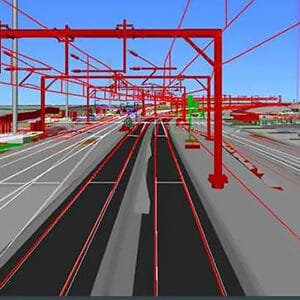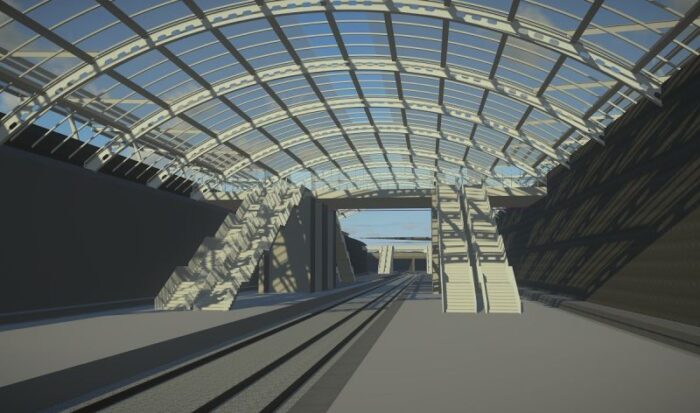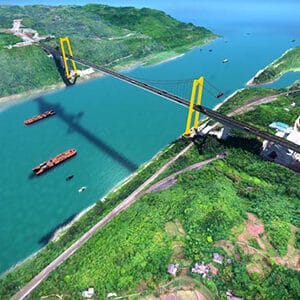Detailed Rail Track Design and Analysis in One Application
One software application for all your metro, light rail, commuter rail, or high-speed rail design project needs. Save time on the design and maintenance of track, station, and yard assets while significantly increasing productivity.
- Support BIM Workflows
-
Advance Your BIM Workflows
OpenRail Designer enables you to easily export digital deliverables, including IFC, to support industry BIM workflows. You can use Item Types to include component attribution for a more efficient, data-rich BIM deliverable. Easily advance your BIM workflows in a digital twin authoring environment while supporting the creation of all traditional and digital design deliverables.
Capabilities
- Add real-world digital context
You can bring real-world settings to your project by gathering context data quickly from a variety of sources, such as point clouds, 3D reality meshes, terrain data, images, and geospatial information. Clearly understand existing conditions and accelerate design modeling workflows and integrate geospatial information to ensure that models are precisely geospatially located. - Streamline collaboration across teams
Enable project information sharing across teams, locations, and disciplines with precision and security. - Visualize designs
Experience your designs in real time with constraint-driven templates, a context sensitive intuitive interface, and dynamic 3D modeling. Visualize the design at any time and on demand within the modeling workflow. No translations, software, or special workflow process is needed. And share realistic visualizations with the public and stakeholders to gather feedback, improve public engagements, and speed project approvals.
- Add real-world digital context
- Design and Analyze Your Rail Networks
-
Design in a high performance, immersive, 3D modeling environment
The software delivers a high performance, immersive, 3D modeling environment that enables instantaneous and interactive parametric modeling of rail corridors. Improve asset quality and reduce rework with a fully localized application.
Capabilities
- Rail and sleeper placement
Rail placement capabilities ensure calculation of precise rail coordinates and joints with track widening tables and cant data. You can also create simple and long sleepers based on your geometry and turnout locations. - Analyze rail track regressions
Convert surveys of track data into full alignments using regression analysis. Determine the best fit geometry alignment of your track from a range of survey data types, including transition types and cant. - Automate rail drawing production
Automate the production of high-quality drawings, including multi-discipline documentation sets that are consistent across the entire project. Get a live view of the project in sheet orientation. As the design changes, so will the sheets. Make edits directly in the sheets and OpenRail Designer will update the source geometry. - Design and analyze corridors, signals, drainage systems, geometry, yard, station, and siding
Use immersive corridor modeling capabilities that support complex modeling and file federation demands required by BIM Level 2 and beyond. Configure and place signals within a rail model. Ensure appropriate drainage is included within rail designs. Combine survey, design rules, and operational requirements to generate optimal geometry for your track. With easy-to-use geometry capabilities and a comprehensive turnout library, you can create yard, station, and siding designs. Rule-based track elements ensure easy adaptation to design changes. - Reuse common design layouts
Use civil cells to ensure standards are implemented, increase design quality, and eliminate the need to repeatedly design common configurations. If you can design it, a civil cell can handle it. There is no limit to the simplicity or complexity of a civil cell. - Create profiles and cross sections
Create profiles and cross sections from any point within the design. View updates on the fly as the design is modified with dynamic cross sections. You can see the ground changing to reflect design edits. Include surface features, corridor components, and notations such as construction limits or stationing.
- Rail and sleeper placement
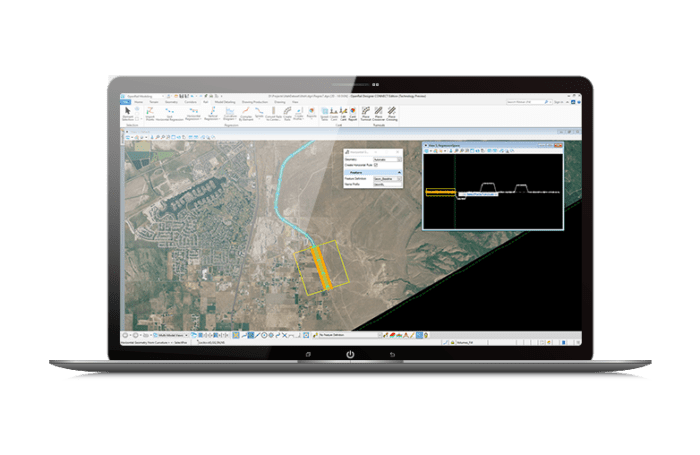
Advance Your BIM Workflows
OpenRail Designer enables you to easily export digital deliverables, including IFC, to support industry BIM workflows. You can use Item Types to include component attribution for a more efficient, data-rich BIM deliverable. Easily advance your BIM workflows in a digital twin authoring environment while supporting the creation of all traditional and digital design deliverables.
Capabilities
- Add real-world digital context
You can bring real-world settings to your project by gathering context data quickly from a variety of sources, such as point clouds, 3D reality meshes, terrain data, images, and geospatial information. Clearly understand existing conditions and accelerate design modeling workflows and integrate geospatial information to ensure that models are precisely geospatially located. - Streamline collaboration across teams
Enable project information sharing across teams, locations, and disciplines with precision and security. - Visualize designs
Experience your designs in real time with constraint-driven templates, a context sensitive intuitive interface, and dynamic 3D modeling. Visualize the design at any time and on demand within the modeling workflow. No translations, software, or special workflow process is needed. And share realistic visualizations with the public and stakeholders to gather feedback, improve public engagements, and speed project approvals.
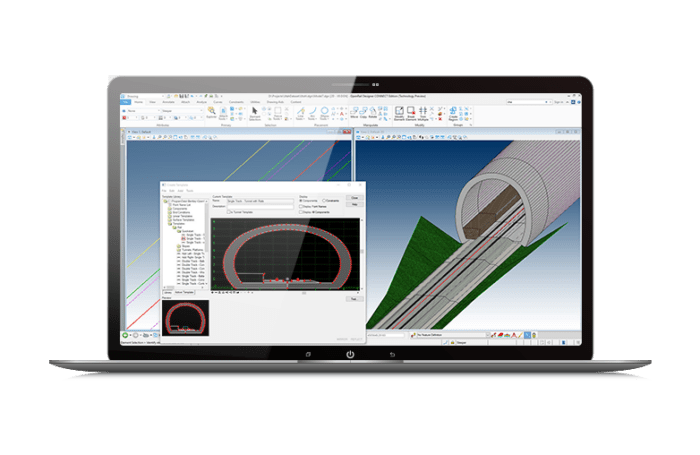
Design in a high performance, immersive, 3D modeling environment
The software delivers a high performance, immersive, 3D modeling environment that enables instantaneous and interactive parametric modeling of rail corridors. Improve asset quality and reduce rework with a fully localized application.
Capabilities
- Rail and sleeper placement
Rail placement capabilities ensure calculation of precise rail coordinates and joints with track widening tables and cant data. You can also create simple and long sleepers based on your geometry and turnout locations. - Analyze rail track regressions
Convert surveys of track data into full alignments using regression analysis. Determine the best fit geometry alignment of your track from a range of survey data types, including transition types and cant. - Automate rail drawing production
Automate the production of high-quality drawings, including multi-discipline documentation sets that are consistent across the entire project. Get a live view of the project in sheet orientation. As the design changes, so will the sheets. Make edits directly in the sheets and OpenRail Designer will update the source geometry. - Design and analyze corridors, signals, drainage systems, geometry, yard, station, and siding
Use immersive corridor modeling capabilities that support complex modeling and file federation demands required by BIM Level 2 and beyond. Configure and place signals within a rail model. Ensure appropriate drainage is included within rail designs. Combine survey, design rules, and operational requirements to generate optimal geometry for your track. With easy-to-use geometry capabilities and a comprehensive turnout library, you can create yard, station, and siding designs. Rule-based track elements ensure easy adaptation to design changes. - Reuse common design layouts
Use civil cells to ensure standards are implemented, increase design quality, and eliminate the need to repeatedly design common configurations. If you can design it, a civil cell can handle it. There is no limit to the simplicity or complexity of a civil cell. - Create profiles and cross sections
Create profiles and cross sections from any point within the design. View updates on the fly as the design is modified with dynamic cross sections. You can see the ground changing to reflect design edits. Include surface features, corridor components, and notations such as construction limits or stationing.
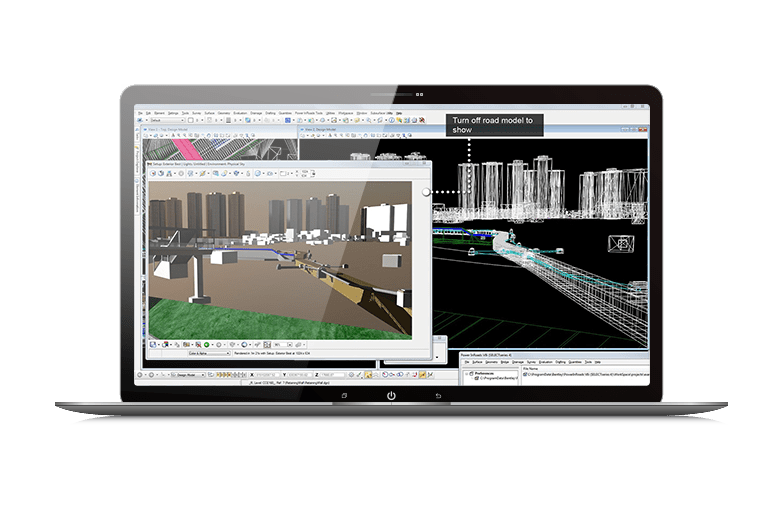
OpenRail Designer
- Design and analyze rail corridors
- Design and place rail signals
- Outline rail track drainage systems
- Automate drawing production
*Prices vary per region. For more options, see licensing and subscriptions section.
user quote
Bentley’s applications translate into inevitable efficiency in the design phase, as well as significant savings in time for review and coordination between disciplines.
— Daniela Aprea, BIM Manager, Italferr S.p.A.
FEATURED USER STORIES
Network Rail + Jacobs
Managing Massive Data, Multiple Systems and a Multidiscipline Team
To bring together all the data and disciplines, Network Rail tasked Jacobs with implementing a route-wide digital twin.
ITALFERR S.P.A.
Integrates Data to Design a Modern Railway Line
Realizing that traditional software would not allow them to meet their goals, Italferr used Bentley applications to help meet their project’s complex needs.
China Railway First Survey and Design Institute Group Co., Ltd
Completes a High-speed Railway in Half the Time
Bentley applications streamlined contributions from all disciplines, improving collaboration efficiency by 50%.
FAQs
Perform conceptual or detailed design on a wide variety of rail projects large and small with tasks such as yard/station design, tunnels, turnout and switch placement, overhead line electrification, site development, and more.
The price of OpenRail Designer varies per region. While there are various types of licensing available, a common choice is the 12-month practitioner license offered through Bentley’s eStore. When you purchase through the eStore, you get a Virtuoso Subscription. This means you get the software and “Keys” (tokens) to redeem for customizable training, mentoring, and consulting services.
Yes, unlike other civil design software, OpenRail Designer provides tools specifically built for the design of railways. This includes an extensive library of standards for cant, turnouts, geometry, and regression analysis. That means that you no longer have to produce rail specific calculations like cant manually and import into the software, or place turnouts as simple geometry. When using OpenRail Designer for your rail projects, you eliminate the errors and loss of productivity that can occur when utilizing road design tools for rail projects.
Yes, OpenRail Designer provides detailed OLE design capabilities and provides standards to allow flexible design of different systems. Parametric component libraries are used to create 3D assemblies of OLE equipment. Drawing production tools create planimetric drawings and cross-sections that can be used in production.
Yes, OpenRail Designer addresses BIM Level 1 and beyond with great use of the 3D model facilitating advancement into BIM Level 2 and beyond. The application supports interoperability and object modeling with 2D and 3D modeling that produces linear, surfaces, and 3D mesh artifacts directly and stores in the file providing real-time visualization that surpasses other civil design tools in the market. You are assured of open information mobility via the 3D model collaboration and i-models allowing the sharing of data from multiple vendors, disciplines, and organizations.
OpenRail Designer also provide greater scalability and level of detail in the design stage to support construction. The application also provides a comprehensive geometric rule engine to address model update requirements and delivers design intent and automatically updates the model to encapsulate change.
Yes, OpenRail Designer offers an open modeling environment to ensure data integration across disciplines to improve collaboration and ensure all users are working from the latest model. Working in the live model mitigates risk by using the data interactively and working among site, rail, road, bridge, drainage, subsurface utilities, geotechnical, and other design teams to help identify conflicts earlier in the process and eliminate construction errors and delays.
Yes, OpenRail Designer is built to help manage change within the design and reflects all edits and updates to ensure both 2D and 3D high-quality construction deliverables. You can produce cross sections, plans, profiles, plan sheets, and more from the 3D model. The model is dynamically linked to the production of plan sheets so you can annotate plans directly in the model and ensure all project standards are reflected in deliverables. You can easily segregate, extract, and package specified data to contractors while ensuring standards are enforced via workspaces and worksets. The application also outputs standard formats for Trimble, Topcon, and Leica for machine-controlled grading and machine guidance.
No, OpenRail Designer is a 3D modeling application that helps you experience designs in real-time and enables you to move through the 3D site model and visually inspect the design for any deficiencies or physical conflicts. You can fully view site features in 3D QA to check grading issues, utility conflicts, and site performance. The software fully integrates with Bentley LumenRT to create models and high-impact visuals and animations to easily communicate the design to stakeholders and clients for project approval.
Intel Pentium-based or AMD Athlon-based processor 2.0 GHz or greater.
Operating System
Microsoft Windows 10, Windows 10 x64, Windows 8, Windows 8 x 64
Memory
16 GB minimum (more memory typically results in better performance)
Disk Space
9 GB minimum free disk space (which includes the 5.6 GB install footprint for a complete installation)
Input Devices
Mouse or digitizing tablet (Digitizing tablet requires vendor-supplied WINTAB driver or Bentley’s Digitizer Tablet Interface, the latter included with OpenRoads Designer installation.)
For the most up-to-date system requirements, visit Bentley Communities.
Licensing and Subscription options
Choose What is Right for You
One-year license with training
Virtuoso Subscription – A popular choice for small and medium-sized businesses
Get access to software that comes with training – fast! Bentley’s eStore offers a convenient way to lease a 12-month license of Bentley software for a low, upfront cost. Every online purchase comes as a Virtuoso Subscription that includes training and auto-renewals. With no contract required, it’s easy to get started quickly.One-time purchase with support
Perpetual License with SELECT
A perpetual license of Bentley software is a one-time purchase, with a yearly maintenance subscription, called SELECT. This includes 24/7/365 technical support, learning resources, and the ability to exchange licenses for other software once a year. With SELECT, you will benefit from:- License pooling, so you can access your software from multiple computers.
- Access additional Bentley software with Term Licenses, which allow you to pay for what you use without the upfront cost of purchasing a perpetual license.
